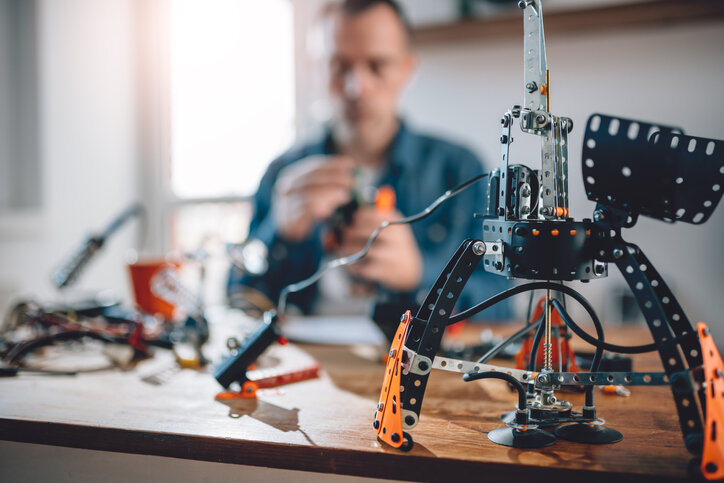In emergency remote teaching, something is missing from subjects that require in-person supervision by a teacher or manual work.
The arts, sports, and technical subjects such as architecture, drawing, and laboratory lessons on biology, chemistry, and electronics, among others, have elements that differentiate them from other academic subjects. In times of pandemic, it becomes complicated to offer real continuity in these disciplines. In Math, Spanish, or History classes, it is easy for instructors to convey online teaching meaningfully using speech, practice, and feedback. Most of the work to understand these subjects is mental. However, what happens with courses that require particular materials, in-person supervision by a teacher, or manual work?
The Complutense University of Madrid depends on a face-to-face regimen, for example, as some of their disciplinary curricula have a high degree of experimentality. “How do you give a canvas restoration course online? In giving a Chemistry grade, how do you handle the lab component?” This questioning by Jorge J. Gómez, Vice-chancellor of Technology and Sustainability at Complutense University, puts in view the greatest danger to the educational experience of students with artistic, sports, or experimental careers. The Vice-chancellor adds that some students of the faculty of Geological and Biological Sciences have to take field trips as part of their training. However, these activities have also been suspended to observe precautionary measures during the quarantine.
The main problem with online technical subjects is that motor skills are not easy to transmit through a screen. The development of such skills depends on close supervision and even physical contact to ensure that the student performs the movement correctly, for example, the blocking technique in football or proper handling of the micropipette in a biology class.
Creativity at work
In previous articles, we have discussed the efforts that elementary, middle schools and high schools have made to maintain continuity of learning in technical subjects, especially extracurricular ones. In the case of art subjects, there have been several examples in which online communication has allowed ensembles, musicals, concerts, and plays, among other activities.
In the virtual classrooms, teachers are doing their best to adapt to the online teaching model. Douglas Russell, a professor of Drawing at the University of Wyoming, knows that things get lost in translation when you only have a screen. However, there is a way to improve student interaction and feedback if you are creative.
“How do you give a canvas restoration course online? In giving a Chemistry grade, how do you handle the lab component?“.
The teacher published the modules of his course for his students with the suggested order to take them. Students can choose the time and the order in which they will work them as long as they complete them before the end date of the class. The model consists of assignments, class discussions, instructional videos, as well as images and support slides. Russell and many other teachers at the university level have done their best to prepare and adapt to asynchronous models that allow students to learn at their own pace while facing the social and psychological realities of the pandemic. Materiality is what Russell describes as what is most lacking in an online session.
“I can’t show students how to draw something directly on their drawing. I can shoot a video or digitally plot the capture of their drawing. However, it is not even remotely the same.” The art teacher is not referring to the tool nor the resource that allows him to interact with the work of his students as if he were present. That is an aspect that technology has managed to cover. Instead, Russel describes the physical-emotional space that a teacher creates by being in the same area as his student, approaching his drawing, and drawing over it while not only giving him instructions but also showing how a stroke should feel when crossing over the sheet.
This presence in teaching occurs in other subjects and is a differentiator between effective and superficial teaching. However, its absence is even more critical in the courses where the practice is the foundation of the discipline. This teaching presence cannot be reproduced 100 percent online. However, it is still possible to establish a competent learning platform at a distance. We just have to keep in mind that this is not a natural and gradual evolution of teaching practice towards the use of EdTech resources. This situation is extraordinary, and it is forcing teachers and students to launch themselves fully into the use of technology for virtual teaching.
Some teachers have experience from offering online classes for years, and they have been preparing themselves in using these technologies long before the present contingency. Clara Lieu, an assistant art instructor at the Rhode Island School of Design, explains that the online model in which she has been working for years, although offering the advantages of reaching students in remote locations and allowing them flexibility, is not so agreeable for teachers. “When you teach in person, you can be more flexible and spontaneous,” she says. The human-figure drawing teacher published a video on five basic errors of online teaching. She reiterated that many areas of opportunity in the field could gradually be assumed through preparation, practice, and willingness to adapt to virtual teaching models.
The technical subjects, arts, and sports can be maintained during quarantine (but with the reduced capacities implicated by distance education) to mitigate the impact of this disadvantage. Institutions such as Tecnológico de Monterrey, the University of Loughborough, and the Complutense University of Madrid offer resources, subscriptions, and, in some cases, online classes for students looking for practice in the arts and sports.
Are you a teacher of any technical, sports, or art subjects? How is your institution facing the challenges of distance education in quarantine times? Tell us in the comments.
This article from Observatory of the Institute for the Future of Education may be shared under the terms of the license CC BY-NC-SA 4.0 
)
)


)